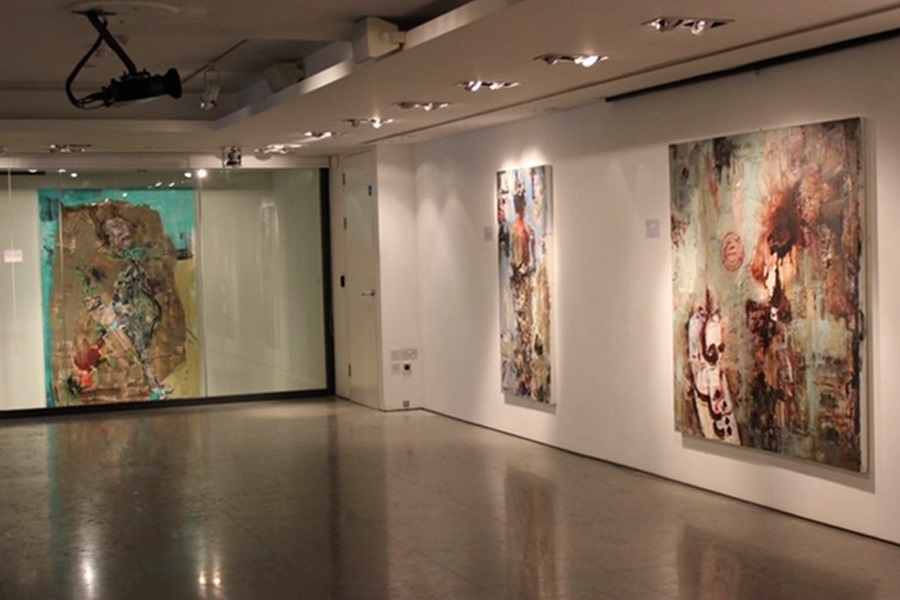Syrian artist Nour Zantah latest exhibition, ‘Ataxia’, at the P21 Gallery in London UK, 31 March 2020 [Nour Zantah]
Tue 31 March 2020:
First-hand experience is a critical factor in the authority of official war art. Syrian artist Nour Zantah has plenty.
Born in Homs in 1989, she watched the violation of her country in the opening months of the civil war. The turning point was when protesters in her home city swarmed around the central clock tower on 19 April 2011, the year that she graduated in Fine Arts from the University of Damascus. At least 17 protesters were killed in the “Clock Tower Massacre”, which became the defining moment in the clashes.
“I witnessed the Homs Clock Tower Massacre, one of the worst days in Syria,” Nour told me. “They shot unarmed civilians and I was very afraid.” She remembers that the people were ordered not to leave their homes so she didn’t have access to art materials. “As an artist, it felt like someone had tied my hands down, it was suffocating. I knew that nothing was going to be the same again, for me or anyone else.”
When the choice was either certain death or exile, her family left Syria; she now lives in London. “You know, I don’t think I can ever go back there; most of the city is now unfit for habitation. He has stolen my childhood.”
Although she felt guilty about making the move, she refused to give up hope that her images can’t have any effect in a conflict that has put many, many heart-wrenching images on our screens. Nour re-visits her city by communicating important issues through her art which combines her creative forces with personal narratives.
“My art production has been drawn from the images and videos I receive spontaneously from my friends or Syrian civilians. All the violence I have been exposed to and have had to engage with vicariously through Syrian social media has been the main source of the collages I’ve created.”
Syria’s conflict began in 2011 with a popular uprising and has gone on to kill hundreds of thousands of people and displace 11 million more. In recent months, upwards of 1 million Syrians have moved towards the Turkish border due to attacks by the Assad regime. He clings to power despite inflicting destruction, fear and pain on his people for the past nine years.
According to Nour, the casualty statistics reeled off by politicians obscure the individual human beings and their suffering. She wants to document her nation’s suffering, and says that her art is both a necessity and a luxury.
![Syrian artist Nour Zantah artwork, 31 March 2020 [Nour Zantah]](https://i1.wp.com/www.middleeastmonitor.com/wp-content/uploads/2020/03/IMG_2646.jpg?resize=328%2C640&quality=85&strip=all&ssl=1)
Syrian artist Nour Zantah artwork, 31 March 2020 [Nour Zantah]
“It happens intuitively as I express the subject of war and its destruction through my painting,” explained the 31-year-old. “It’s based on the result of all the violence; on the victims who haven’t had the opportunity to finish telling their stories of suffering, and I’m here to do it for them. Intuitively, this is what I‘m doing.”
Each one of her artworks is infused with smoky cut-outs of fallen, collapsed and entangled buildings to conjure up the images of the impact of war. She pointed out that, just like the mix of emotions — the anger, sadness and intellectual and sensory chaos — her work has many layers. She builds on different images that she collects and then explores them by re-working it all in her paintings.
Her aim is for viewers to focus on all of the images that her paintings are made up of; the details within the whole. As they draw closer to the canvas, they can sense intimate stories among the events conveyed by the painting.
“It’s similar to the concept of war, when people see it from afar; they understand it but no such feelings are stirred. When they look closer, though, and see the chaos and meet individual victims, it all changes, it’s much deeper. They bring an immediacy and a kind of familiarity and contemporaneity to the painting, whilst simultaneously undermining that by the horrific nature of the subject matter.” This is her way of taking a stand and protesting.
Last week, Nour Zantah’s latest exhibition, “Ataxia”, was staged at the P21 Gallery in London. She showcased 22 graphic paintings that have evolved with the war, many depicting the ruination of Syria’s streets and villages.
“Ataxia,” she told me, “is meant to bring to mind two ideas: the first arises from the fact that it sounds like attack, and so conveys, in a sense, violence and war.” Ataxia is also a medical term used to describe the loss of full control of one’s body. “Thus, the word links, for me, violence and its results: the loss of control of one’s body, and indeed of one’s destiny, whether through death, or through injury and incapacity, or indeed through exile.”
Frustrated at the huge scale of the war that the West has become “bored with”, she wanted to arrange an exhibition that provided a window on its consequences. “I wanted to redress the decreasing levels of understanding and knowledge about what has happened, and is still happening, in Syria.”
Nour now has a PhD under her belt from the University of Northampton. Influenced without doubt by the traditional art of her homeland, she adds a particular focus on the local context of her home city, such as calligraphy and the rows of corner shops and markets standing pockmarked by shrapnel and bomb blasts.
Plagued by personal tragedy and political events, the themes of her work are compelling and resonate with urgent issues to be addressed, such as oppression and unstable political environments. One painting called “Solitude” is filled by broad brush strokes and a remarkable combination of image and text; the Arabic calligraphy asks, “Where have all the memories gone? Everything has vanished.”
“I have a special connection with ‘Solitude’. I’m not sure how this connection developed. It basically represents the feeling I have continuously, where thoughts are overflowing perpetually during my exile. In other words, I sought to express through this painting the impact of the sounds of war on myself at the moment of isolation, nostalgia, fear, contradiction and loss of hope.”
In another painting, blood drips down the back of a man about to be treated for his bullet wounds while rising from the ashes of demolished and burning buildings. It does not fail to arouse intense feelings.
The man’s photograph was taken in a field hospital in Douma, Syria, on 20 September 2014 after several air strikes hit the city. “The paint strokes in this appeared like explosions,” explained Nour, “in which I see the surface of this painting as a heavily worked one, and the paint is extremely weighty. I intentionally scraped the canvases to achieve distressed textures that mimic the presence of destroyed buildings; fragmented, broken and corroded, these surfaces increased the power of the subject’s presentation.
The painting reflects the emotions I experienced when I saw the picture of his wounds, since it reminded me of other Syrians who faced death from bullet wounds.
Politically as well as aesthetically, this collection effectively captures the numbing tedium of endless war in which each item becomes more than just a painting. She had to express her feelings, so she took the human figure and human psychology and how war affected the Syrians psychologically, and intentionally distorted the faces and the bodies to show the psychological effect on people and the grim consequences of war.
“It’s not meant to be beautiful,” Nour Zantah concluded. “It’s a history of my emotions responding to the development of the Syrian war, and none of that is beautiful.”
-middleeastmonitor
Think your friends would be interested? Share this story!



![syria artIMG_2664 Syrian artist Nour Zantah artwork, 31 March 2020 [Nour Zantah]](https://i2.wp.com/www.middleeastmonitor.com/wp-content/uploads/2020/03/syria-artIMG_2664.jpg?w=463&h=309&quality=85&strip=all&ssl=1)



